Plants often grow more when then are together with a diversity of species than when they are growing in single-species stands. Using both observational studies and experimental manipulations in a subtropical forest in China, we found that while the productivity of both seedlings and adult trees was enhanced with greater species diversity, plant growth got even bigger boosts when neighboring species were more distantly related (greater phylogenetic  diversity). Interestingly, this effect of phylogenetic diversity only happened is soil teaming with microorganisms, and not in sterile soil. In addition, the diversity of fungi associated with plant roots increased as the phylogenetic or species diversity of plants increased, but the abundance of pathogens among those fungi declined when phylogenetic distances among neighbors was greater. These findings highlight how enhancing phylogenetic diversity in plant communities can reduce the impacts of pathogenic fungi, allow greater growth of the plants, and create the observed relationship between plant diversity and productivity.
diversity). Interestingly, this effect of phylogenetic diversity only happened is soil teaming with microorganisms, and not in sterile soil. In addition, the diversity of fungi associated with plant roots increased as the phylogenetic or species diversity of plants increased, but the abundance of pathogens among those fungi declined when phylogenetic distances among neighbors was greater. These findings highlight how enhancing phylogenetic diversity in plant communities can reduce the impacts of pathogenic fungi, allow greater growth of the plants, and create the observed relationship between plant diversity and productivity.
Liang, Minxia, Xubing Liu, Ingrid M. Parker, David Johnson, Yi Zheng, Shan Luo, Gregory S. Gilbert, and Shixiao Yu. (2019). Soil microbes drive phylogenetic diversity-productivity relationships in a subtropical forest. Science Advances 5:eaax5088